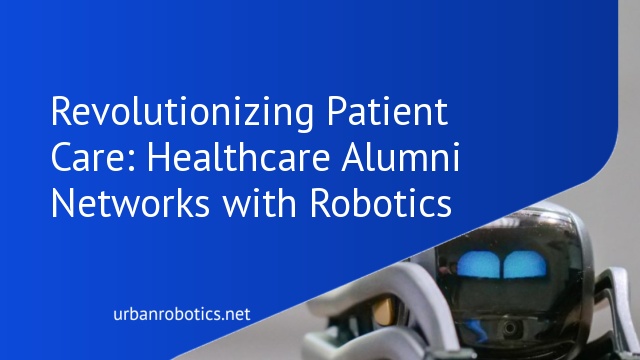Understanding Healthcare Alumni Networks
Healthcare alumni networks connect professionals from the same educational institutions, leveraging shared experiences to foster collaboration and growth. These networks play a crucial role in the continuous development of the healthcare field.
Importance of Alumni Networks
Alumni networks offer significant benefits by providing a platform for continuous learning, mentorship, and career advancement (e.g., webinars, job boards). These networks extend beyond social connections to include professional opportunities, industry insights, and collaborative projects. Engaging with alumni networks enriches professional skills and keeps members updated on advancements in their field, including the integration of robotics technologies.
Structure and Functionality
Healthcare alumni networks typically feature multiple components: member directories, discussion forums, and organized events (e.g., reunions, conferences). Member directories facilitate easy access to contact information, enabling collaboration. Discussion forums support knowledge sharing and problem-solving, while events provide opportunities for face-to-face interaction. By maintaining these structures, alumni networks enhance professional connectivity and promote the adoption of emerging technologies like robotics within healthcare.
Integration of Robotics in Healthcare
The integration of robotics in healthcare alumni networks creates unparalleled opportunities for advancing medical technologies. This fusion promotes innovation and enhances professional growth.
Evolution of Robotics in Medicine
Robotics in medicine has evolved rapidly since the early 2000s. Initially, robots performed basic surgical tasks, but they now handle complex procedures with precision. For example, the Da Vinci Surgical System enables minimally invasive surgeries, reducing recovery times. With advancements in AI, robotics is entering diagnostics, rehabilitation, and patient care. Healthcare alumni must stay updated on these developments, as robotics continues to transform medical practices.
Key Benefits of Robotics
Robotics offers several key benefits in healthcare. Precision and accuracy in surgeries reduce complications and improve patient outcomes. Automated systems streamline administrative tasks, allowing healthcare professionals to focus on patient care. Robotics also enhances remote monitoring, providing continuous patient data access. By embracing these benefits, healthcare alumni can leverage robotics to drive efficiency and improve medical care quality.
The Synergy between Alumni Networks and Robotics
Healthcare alumni networks, bolstered by cutting-edge robotics, create a fertile ground for collaboration and innovation. Integrating robotics into these networks provides numerous benefits, ensuring continuous advancements in the medical field.
Collaboration and Innovation
Integrating robotics into alumni networks fosters collaboration and innovation. Alumni can share insights on new robotic technologies, driving advancements in healthcare. For instance, virtual platforms allow alumni to discuss AI-driven surgical robots and telemedicine applications, enhancing patient care. Networking events enable members to collaborate on research and development projects, ensuring the continuous evolution of medical technologies.
Case Studies of Successful Integration
Case studies demonstrate successful integration of robotics in healthcare alumni networks. For example, the University of California, San Francisco (UCSF) alumni network collaborated with robotic companies to advance surgical techniques. At Johns Hopkins, the alumni network has worked on developing robotic systems for minimally invasive procedures. These collaborations showcase the power of combining alumni expertise with robotic innovations, leading to significant improvements in medical outcomes.
Role of Alumni in Advancing Robotics
Alumni networks play a crucial role in advancing robotics within healthcare. They leverage collective expertise and resources to drive significant robotic innovations.
Sharing Expertise and Knowledge
Alumni with experience in robotics share their knowledge through workshops and webinars. They provide insights on AI-driven surgical robots and telemedicine applications, which help current practitioners stay updated. For example, UCSF alumni conduct sessions on robotic surgery techniques, improving procedural efficiency and patient outcomes.
Funding and Resource Allocation
Alumni networks contribute funds and allocate resources for robotics research and development. They help secure investments for cutting-edge projects and support startups in the field. Johns Hopkins alumni, for instance, have funded initiatives in robotic-assisted diagnostics, accelerating technological advancements and enabling prototype development.
Challenges and Opportunities
Healthcare alumni networks integrating robotics face unique challenges and opportunities, fostering innovation and collaboration.
Overcoming Technological Barriers
Technological barriers present significant challenges in integrating robotics into healthcare alumni networks. Alumni must address issues like interoperability with existing systems, data security concerns, and high costs. For example, ensuring robotic devices can seamlessly share data with hospital databases remains a top priority. Moreover, alumni networks can leverage collaborative platforms to share resources and expertise, helping to reduce costs. Addressing these challenges collectively enhances the potential for successful robotics integration.
Future Prospects
The future of healthcare alumni networks with robotics presents numerous opportunities. Alumni networks can drive further advancements in AI-driven diagnostics, telemedicine, and rehabilitation services. By fostering collaboration through regular workshops and funding initiatives, networks can accelerate the development of cutting-edge technologies. For instance, alumni-led projects might focus on creating more precise surgical robots or enhancing telehealth interfaces. These innovations promise to revolutionize patient care, making significant strides in medical technology advancements.
Conclusion
Healthcare alumni networks are playing a pivotal role in the evolution of robotics within the medical field. By leveraging collective expertise and resources, these networks are not only addressing current challenges but also paving the way for future innovations. As we look forward, the collaborative efforts in AI-driven diagnostics, telemedicine, and rehabilitation services promise to revolutionize patient care. With ongoing support and shared vision, our healthcare systems stand to benefit immensely from these technological advancements.





